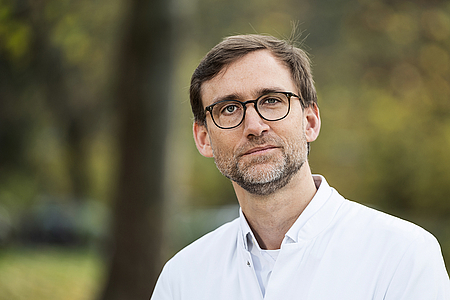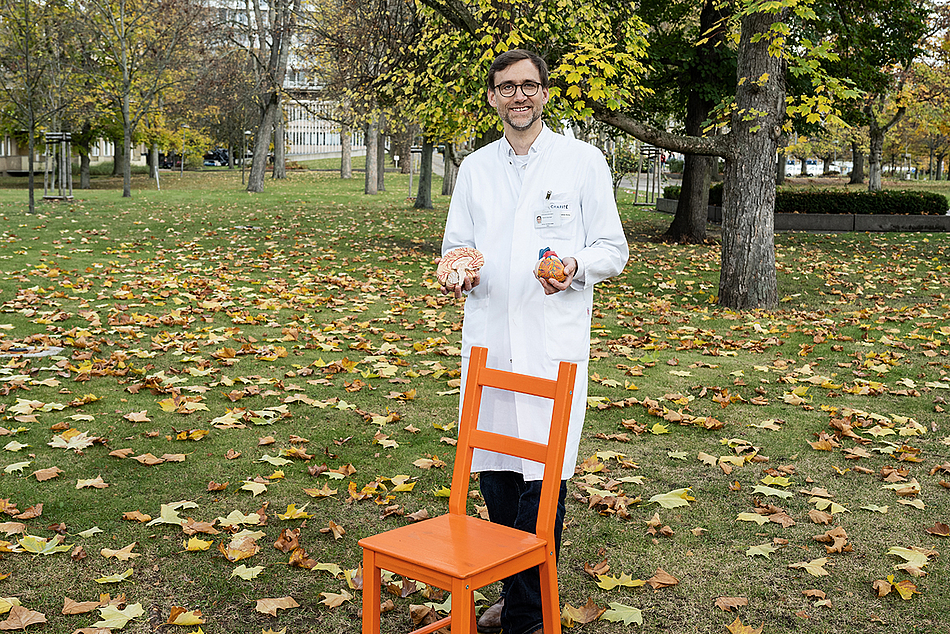When the brain affects the heart – insights into stroke research
Prof. Dr. Christian Nolte is a senior physician at the Department of Neurology at Charité - Universitätsmedizin Berlin and an expert in the treatment of acute ischemic stroke. Besides stroke research, he is particularly interested in the interaction between heart and brain. In addition to his clinical activities, Mr. Nolte gets support by Stiftung Charité as a BIH Clinical Fellow. He is using this opportunity to contribute in improving personalized prediction of cardiac complications in ischemic stroke. What exactly lies behind his research approach, why he chose to work in neurology and how he finds balance to his daily work – he told us in this interview.
Professor Nolte, your project deals with the heart-brain interaction in ischemic stroke. What exactly is this about?
The topic of heart-brain interaction has become increasingly important in recent years. For a long time, researchers focused on identifying heart diseases that can subsequently cause brain diseases. As it is well known, the heart supplies the brain with blood and circulatory disorders in the brain are accordingly often caused by the heart. This is also important in the treatment of stroke and is often decisive for therapy. However, my research group, among others, is concentrating on the opposite way: Can damage to the brain also cause damage to the heart? And yes, we were able to show that strokes in the so-called insular lobe of the brain in particular lead to subsequent heart damage. This is interesting because the insular lobe controls the autonomic nervous system and the autonomic nervous system controls the heart. Stroke patients with such damage again have a poor prognosis and could perhaps benefit from special therapeutic approaches.
What do you hope to achieve with your research?
Needless to say we hope to show that patients with stroke-induced heart damage benefit from specific treatment. This would allow us to improve the prognosis of these patients. But first of all many smaller goals must be achieved. For a better understanding we use precise MRI data at Charité, which gives us closer insights into the meaning of localization, shape, and form of the strokes. Thereby we hope to understand better whether and how we can predict cardiac disease: Can we show even better that certain regions in the brain can cause cardiac disorders, including cardiac arrhythmias for example?

Funding program
BIH Clinical Fellow
Funding period
From 2022
Research area
Neurology
Project title
Heart-brain interaction: improving personalized prediction of cardiac complications in ischemic stroke by using infarct location and infarct patterns
Institution
Charité – Universitätsmedizin Berlin
From 2009
Head of the Stroke Unit at the Campus Benjamin Franklin at Charité – Universitätsmedizin Berlin
From 2018
Head of the Trial Team at the Center for Stroke Research at Charité – Universitätsmedizin Berlin
Can we also predict other organ disorders (outside the heart)? Of particular interest is the so-called broken heart syndrome, which we usually know from situations that are emotionally highly stressful. Here again we are looking for connections to the autonomic nervous system.
There are two types of stroke: The hemorrhagic one, which is caused by a cerebral hemorrhage, and the ischemic one, which occurs due to a sudden decrease in blood flow to the brain. You are mainly focusing on the ischemic one. Why?
Ischemic and hemorrhagic stroke differ fundamentally in pathophysiology and therapy. Ischemic stroke is also significantly more frequent.
Therefore we can analyze significantly larger amounts of data in research on ischemic stroke, thus making statistically meaningful statements better and faster and ultimately helping more patients numerically.
How can the typical stroke patient be described?
That can be answered quite well: The average male or female stroke patient is around 73 years old. About the same number of women as men are affected, although one might think that women are normally less likely to suffer a stroke than men. The gender balance is explained by the fact that women usually live longer than men - they have sort of more time (in life) to suffer a stroke. On average, women are about five years older than men when they have their first stroke. In addition, the causes of strokes vary according to gender. With regard to men the main reason is severe arteriosclerosis. Women, on the other hand, are much more likely to have strokes due to heart disease. This means that women are overrepresented in our studies.
You have been working in neurology for many years. Why did you choose this medical sector in particular?
For me personally, neurology is simply the most exciting subject in medicine. You have to be very "detective-like." Patients don’t come to us and say, "I'm having a stroke" or "I have Parkinson's disease." Instead, they come to us with problems concerning walking or climbing the stairs for example. With the clinical-neurological examination, the cause of the complaints can usually be narrowed down quite well. The clinical examination allows the assignment of symptoms to syndromes and from that point we come to the disease and therapy. In the past, neurology was perhaps considered to be somewhat "top-heavy". Meanwhile neurology has become a therapeutic subject with many treatment options. Neurology has even become an indispensable part of the emergency room. Every third patient in the emergency room has a neurological deficit. In cases of dizziness and headaches, for example, neurologists are now often the first counterparts.
You were working not only in Germany, but also in London, Manchester and Toronto. What comes in your mind when you think back to this international experience?
In Great Britain, I found the close teamwork particularly remarkable. Things were much less hierarchical there than here in Germany. And I remember a very friendly atmosphere in the clinic. In Canada, on the other hand, I didn't work in neurology but in cardiology. What impressed me most was how much health care and research is made possible by foundation funding. It's great that this is also being given a higher priority in Germany.
What do you particularly like about Berlin, independently of your work?
Born in a small town in Lower Saxony, I really like Berlin as a large city. I appreciate the great cultural offerings containing many theaters, the impressive infrastructure and the honest nature of the people who live here. I think it’s very likeable that people here don't mince their words. And I also like the fact that people here are generally a bit more critical of – let's say – the authorities and question many things. In short: I really enjoy living in Berlin and I wouldn't want to move away.
How do you find balance to your work, do you use Berlin's diverse offerings for example?
Above all I find balance in my family, in particular with my wife and my three daughters. Apart from that, I'm a friend of quieter activities. We have a garden where I love to spend time. This year I even made jam from our currants myself (laughs). Apart from that, I like to go hiking and jogging, as this is an excellent way to clear my head.
Last but not least, let’s move to our traditional final question: if you could invite three people (dead or alive) to a fictional dinner, who would they be?
That is an exciting question! I would like to have dinner with three inspiring personalities from my field: the two neurologists Jean-Martin Charcot and Joseph Babinski. The former is considered the founder of neurology in France. Babinski contributed a lot to neurological-topological diagnostics. In addition, I would like to have Carl Westphal with us. He was one of the first heads of neurology (Nervenheilkunde) at Charité. Mr. Westphal was instrumental in the emancipation of neurology from psychiatry.
December 2022 / Marike de Vries & Marie Hoffmann
